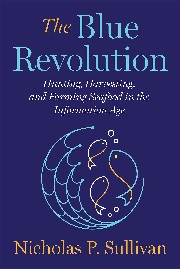The Blue Revolution. Hunting, Harvesting and Farming Seafood in the Information Age

Nicholas Sullivan
Island Press, £25.00
The ocean is vast, covering over 70% of the globe’s surface. It provides substantial food resources to the global population, valued at over US$250 billion in 2022, expected to rise to US$350 billion by 2025.
Despite this assumed endless supply of fish, hunting seafood has not been without similar issues as resource exploitation on the land. In The Blue Revolution, Nicholas Sullivan takes a very North America-centric view of the modernization of the industries that provide fresh, nutritious fish on our plates.
This is a fascinating book as Sullivan weaves stock statistics in with the voices from fishers to academics and industry. He advocates for sustainable harvesting of wild seafood (including using sensing technology) as the way to feed the growing demand for fish protein (recently seafood took over from the red meat industry as the dominant animal protein supplied to consumers' plates).
The second part of the book focuses on the aquaculture industry and advances in technology, from sea-based cages for salmon to land-based recirculating aquaculture systems for anything from fish to mussels. Sullivan then shows how satellite-based remote sensing and big data are helping to deal with illegal fishing (worth US$35 billion per annum) with vivid descriptions of days long chases of pirate vessels across the oceans.
Concluding his well-researched book, Sullivan highlights the issues that global warming could place on wild seafood populations and how protection of large areas of the ocean can benefit biodiversity and increase the harvest of seafood. The North American focus does mean that some of the other world stories do not come into play (although Iceland gets a chapter to itself), however, it is well worth reading for anyone interested in where seafood comes from. They might be surprised by the background story to fish on their plate.
Iain Gordon FRSB


